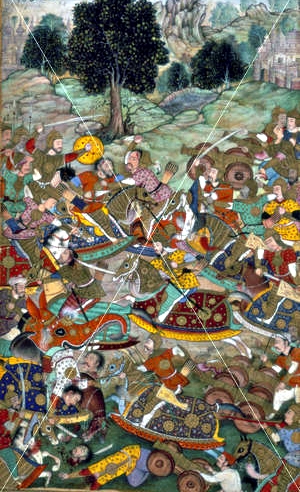Battle of Khanwa
| Battle of Khanwa | |||||||||
|---|---|---|---|---|---|---|---|---|---|
| Part of Expansion of the Mughal Empire | |||||||||
 Rajput Army armed against Mughal Army |
|||||||||
|
|||||||||
| Belligerents | |||||||||
| Mughal Empire |
|
||||||||
| Commanders and leaders | |||||||||
|
Babur Humayun Ustad Ali Quli Mustafa Rumi Chin Timur Khan Mir Mohib Ali Khalifa Mir Abdul Aziz Mir Muhammed Ali Khan Khusrau Shah Kokultash Kassim Husain Khan Muhammad Zaman Mirza Askari Mirza Hindal Mirza Sayyed Mehdi Khwaja Asad Malik Hast Raja Sanghar Ali Khan Raja Silhadi (Switched Sides -Betrayed Rajput Confederate) |
Hasan Khan Mewati † Rawal Uday Singh Wagari † Medini Rai Sultan Nusrat Shah |
||||||||
| Strength | |||||||||
| 60,000 Mughals 8000 Kabul Reinforcements 40-50 Field Artillery |
50,000 Rajputs 30,000 Purbiyas (under silhadi) 10,000 Afghans 12,000 Muslim Rajputs 500 War Elephants (Neutral claims) |
||||||||
The Battle of Khanwa was fought near the village of Khanwa, about 60 km west of Agra, on March 17, 1527. It was the second major battle fought in modern-day India, between the invading forces of the first Mughal Emperor Babur and the Rajput forces led by Rana Sanga of Mewar, after the Battle of Panipat. The victory in the battle consolidated the new Mughal dynasty in India.
The Rajput ruler Rana Sanga had sent an ambassador to Babur at Kabul, offering to join in Babur's attack on Sultan Ibrahim Lodi of Delhi. Sanga had offered to attack Agra while Babur would be attacking Delhi. However, while Babur did attack Sultan Ibrahim Lodi, and took over Delhi and Agra, Sanga made no move, apparently having changed his mind. Babur had resented this backsliding; in his autobiography, Babur accuses Rana Sanga of breach of agreement The historian Satish Chandra speculates that Sanga may have imagined a long drawn struggle taking place between Babur and Sultan Ibrahim Lodi following which he would be able to take control over the regions he coveted. Alternatively, writes Chandra, Sanga may have thought that in the event of a Mughal victory, Babur would withdraw from Delhi and Agra, like Timur, once he had seized the treasures of these cities. Once he realized that Babur intended to stay on in India, Sanga proceeded to build a grand coalition which would either force Babur out of India or else confine him to Punjab. In early 1527, Babur started receiving reports of Sanga's advance towards Agra. It was treachery of a section of Sanga's army that resulted in his defeat.
After the First Battle of Panipat, Babur had recognized that his biggest danger came from two quarters: Rana Sanga, and the Afghans ruling in Eastern India at the time. In a council that Babur called, it was decided that the Afghans represented the bigger danger, and consequently Humayun was sent heading an army to fight the Afghans in the east. However, upon hearing of Rana Sanga's advancement on Agra, Humayun was hastily recalled. Military detachments were then sent by Babur for the conquest of Dholpur, Gwaliyar, and Bayana. These were strong forts forming the outer boundaries of Agra. The commanders of Dholpur and Gwaliyar surrendered their forts to Babur accepting his generous terms. However, Nizam Khan, the commander of Bayana opened negotiations with both Babur and Rana Sanga. Babur's initial military detachment to Bayana was also defeated and dispersed by Rana Sanga's forces. However, subsequently, Bayana surrendered to Babur.
...
Wikipedia
